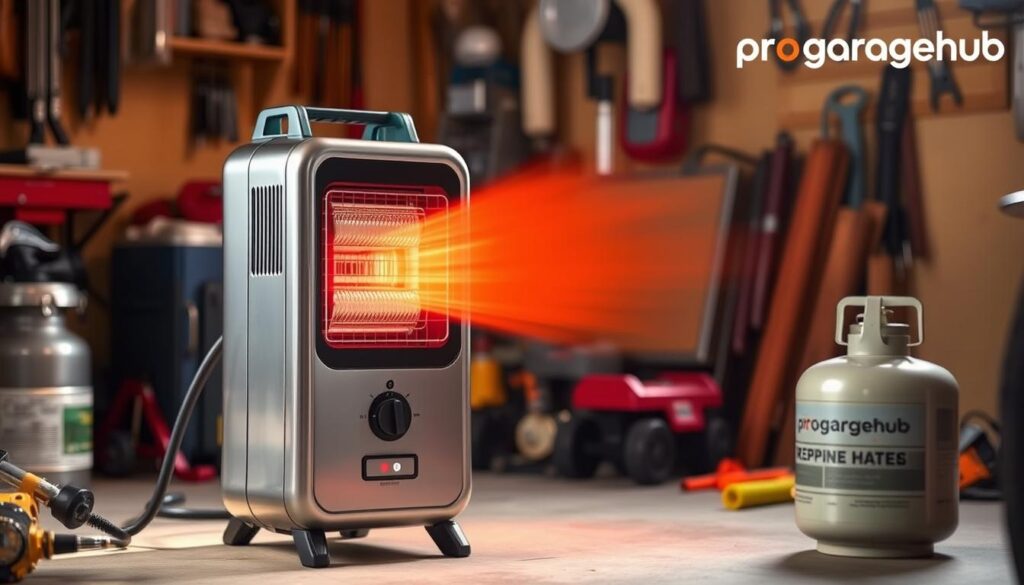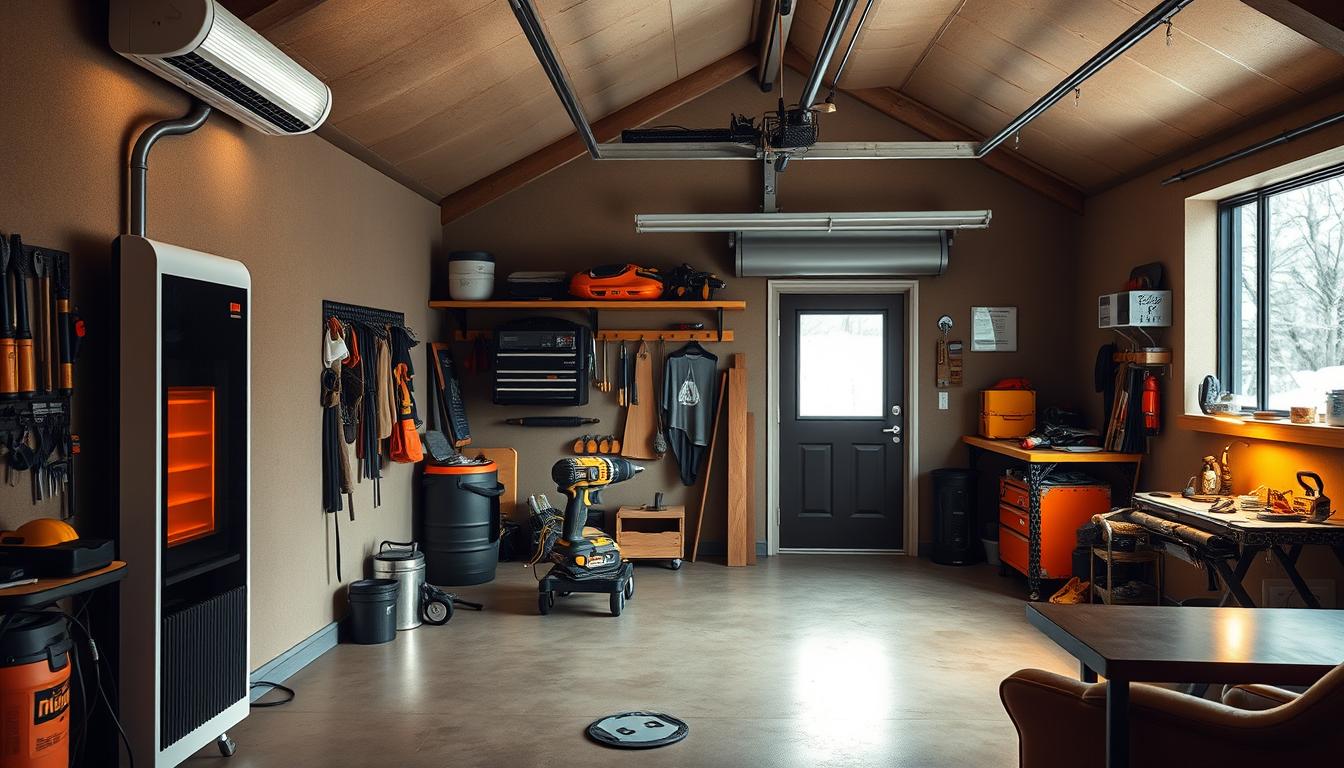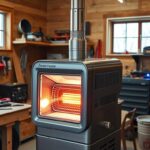Keeping your garage warm is key, whether it’s for work, storage, or parking. This article looks at different ways to heat your garage. We’ll talk about electric space heaters, forced air systems, radiant heating, and wood stoves. We’ll also discuss their pros and cons to help you choose the best option for your space and wallet.
Key Takeaways
- Explore a range of effective heating methods for your garage, including electric space heaters, forced air systems, radiant heating, and wood stoves.
- Understand the importance of proper insulation and air sealing to maximize the efficiency of your garage heating system.
- Learn about safety considerations and energy-saving tips to ensure your garage heating is safe and cost-effective.
- Discover how to combine multiple heating methods for optimal comfort and flexibility in your garage.
- Gain insights into the factors to consider when choosing the right heating solution for your specific needs and budget.
Why Heating a Garage is Important
Heating your garage is key for homeowners and hobbyists. It keeps your tools and equipment safe from cold damage. It also makes your workspace comfortable for projects or maintenance.
Protect Your Tools and Equipment
Extreme cold can harm many materials, like metals and plastics. It makes them brittle and prone to breaking. Heating your garage protects your tools and equipment, saving you money and hassle.
Create a Comfortable Workspace
A warm garage is great for working on projects. Whether it’s car repairs or building furniture, a cozy space helps you stay focused. Heating your garage keeps you comfortable and productive.
Getting a good heating system for your garage is smart. It keeps your stuff safe and makes working there enjoyable. By heating your garage, you create a space that supports your hobbies all year.
Insulating Your Garage for Better Heating
Insulation is key for heating your garage right. By insulating walls, ceiling, and doors, you boost your heating system’s efficiency. This helps keep warmth in and cuts down on energy costs. You can choose from fiberglass, rigid foam, or spray foam, depending on your garage’s needs.
Adding insulation to an uninsulated garage can greatly improve heating. It stops heat from escaping, making your heating system work better. This means lower bills and a cozier workspace.
Insulation Options for Uninsulated Garages
For heating an uninsulated garage, you have a few insulation choices:
- Fiberglass insulation is a cost-effective option that insulates well against heat and sound.
- Rigid foam boards are great for walls and ceilings because they insulate well and are easy to install.
- Spray foam insulation creates a tight seal, perfect for areas hard to reach.
The right insulation for your garage depends on its size, your budget, and its construction.
| Insulation Type | R-Value | Ease of Installation | Cost |
|---|---|---|---|
| Fiberglass | R-13 to R-30 | Moderate | $ |
| Rigid Foam | R-5 to R-7 per inch | Easy | $$ |
| Spray Foam | R-3 to R-6 per inch | Difficult | $$$ |
Choosing the right insulation is important. Proper installation ensures your garage heating system works well. This is key for how to heat an uninsulated garage.
Electric Space Heaters: A Simple Solution
Electric space heaters are a great way to heat your garage without spending a lot. They are small, easy to move, and don’t need to be installed. This makes them a simple choice for adding warmth to your garage.
Choosing the Right Size Heater
To make sure your electric space heater heats the garage cheap, pick one that fits your garage’s size. Here’s a simple guide:
- For a small garage (up to 150 sq. ft.), a 1,500-watt heater is enough.
- For a medium-sized garage (150-300 sq. ft.), choose a 2,000-watt heater.
- For a bigger garage (300-500 sq. ft.), a 3,000-watt heater will work well.
Choosing the right size heater helps it work better. It will warm your garage well without using too much energy.
Safety Considerations
When using an electric space heater, safety is key. Keep it away from things that can catch fire, like curtains or boxes. Also, make sure there’s enough air to avoid carbon monoxide buildup.
By following these tips, electric space heaters can be a cheap way to heat the garage. They provide warmth without costing a lot.
Forced Air Heating Systems
Heating your garage can be easy with your home’s forced air system. Just extend the ductwork from your HVAC to your garage. This way, you can heat your garage just like the rest of your home.
Extending Your Home’s HVAC System
Extending your HVAC to the garage is a smart move. But, you need to think it through. Look at your garage’s size, how close it is to your home, and if you can add ductwork. This might save money if your garage is attached or near your house.
Here are some things to think about when heating your garage with your home’s system:
- Check if your HVAC can handle the extra work of heating the garage.
- Find the best spot and size for vents or registers for even heat.
- See how easy it is to run new ductwork from your home to the garage.
- Make sure your garage is well-insulated and sealed to keep the heat in.
By linking your garage heating to your home’s HVAC, you get a smooth and energy-saving way to keep your garage cozy all year.
Radiant Heating: A Cozy and Efficient Option
Radiant heating systems are a great way to warm up your garage. They use tubes or cables in the floor or walls to heat objects directly. This method provides a more even and cozy warmth than air-based heating.
One big plus of radiant heating is how it warms up the space. It heats the floor, walls, and even your tools. This means you get a consistent warmth without cold spots or drafts.
These systems are also very energy-efficient. They directly heat surfaces, which cuts down on heat loss and waste. This saves you money on your energy bills, making them a smart choice for heating your garage.
| Advantages of Radiant Heating | Disadvantages of Radiant Heating |
|---|---|
|
|
While radiant heating might cost more to install, its long-term savings and comfort are worth it. It’s a great way to make your garage a warm and welcoming space. Plus, it helps you save on energy costs.
Wood Stoves: A Traditional and Eco-Friendly Choice
Looking for a way to heat your garage that’s both efficient and eco-friendly? Think about a wood stove. These traditional heaters not only warm up your space but also make it cozy. They’re a great choice if you want to save money on energy bills.
Proper Installation and Ventilation
But, it’s key to make sure your wood stove is installed and ventilated right. This ensures it works safely and efficiently. Not following local building codes and safety rules can be dangerous, like causing fires or carbon monoxide poisoning.
- Hire a licensed and experienced professional to install your wood stove.
- Ensure the stove is placed on a non-combustible surface and that there is adequate clearance from nearby walls and objects.
- Install a proper chimney or flue system to ensure proper ventilation and exhaust of smoke and fumes.
- Consider adding heat shields or other safety features to further minimize fire risks.
By taking the right steps and following best practices, you can enjoy a wood stove’s warmth and charm in your garage. It’s a smart choice for heating your garage cheaply and making it a cozy workspace all year.
“A wood stove is not only a practical heating solution, but it also adds a touch of rustic charm to any space.”
Infrared Heaters: Targeted Warmth
Infrared heaters are a smart choice for warming up your garage. They heat objects and people directly, unlike traditional heaters that warm the air. This makes them more efficient and can keep your garage cozy when it’s cold.
These heaters send out invisible infrared radiation that people and objects absorb. This way, they heat up directly, without warming the whole garage. This method is efficient because it doesn’t waste energy on heating empty space.
Infrared heaters are great for heating specific spots in your garage. You can place them where you work or where you spend most of your time. This way, you save energy by not heating the whole garage.
| Feature | Benefit |
|---|---|
| Targeted Heating | Focuses warmth on specific areas, reducing energy waste |
| Efficient Heat Transfer | Directly warms objects and people, not just the air |
| Compact and Portable | Can be easily moved and positioned as needed |
| Instant Warmth | Heats up quickly, providing immediate comfort |
Infrared heaters are a smart choice for heating your garage. They offer targeted, efficient, and cost-effective warmth. By focusing on what needs to be heated, they make your garage a comfortable and functional space without wasting energy.
Heating Your Garage Efficiently
To heat your garage well, focus on two key areas: insulation and air sealing. These steps help your heating system work better and save on energy costs.
Proper Insulation
Insulation is crucial for keeping warmth in your garage. Without enough, the heat you make can go out quickly. Using top-notch insulation like fiberglass or spray foam helps keep the heat in.
Air Sealing
Air sealing is also vital for a warm garage. Gaps and cracks let warm air out, wasting energy. Fixing these with weatherstripping and sealing air leaks keeps the warmth in.
By improving insulation and sealing air leaks, you make your garage warmer and more energy-smart. This way, you can enjoy a cozy garage without wasting resources.
Portable Propane Heaters: Convenience and Versatility
Portable propane heaters are a smart choice for warming your garage without spending a lot. They are simple to set up and can be moved easily. This makes them perfect for garages without a fixed heating system.
These heaters are small but pack a big punch when it comes to heating. They can quickly make your workspace warm and inviting.
One big plus of portable propane heaters is how easy they are to move. Unlike fixed systems, you can take them where you need the most heat. This is super useful in garages that are used for many things, like a workshop or storage area.
| Feature | Benefit |
|---|---|
| Portability | Easy to move and position for targeted heating |
| Heating Capacity | Powerful enough to warm up a garage efficiently |
| Fuel Efficiency | Propane is a cost-effective heating source |
| Quick Setup | No complex installation required |
While portable propane heaters are handy and versatile, safety is key. Make sure you have good ventilation and handle the propane fuel safely. With the right precautions, these heaters can be a smart and affordable way to heat the garage cheap.

In short, portable propane heaters are a smart pick for how to heat the garage cheap. They are easy to move, heat well, and use fuel efficiently. Just remember to follow safety rules and the maker’s guidelines to enjoy their benefits.
Combining Heating Methods for Optimal Results
Heating your garage doesn’t have to be one way. Sometimes, mixing different heating methods works best. This way, you can make a heating system that fits your garage’s unique needs.
Start with a main heating system, like forced air or radiant heat. Then, add extra heat with portable electric or propane heaters. This mix ensures your garage is warm everywhere, with the option to adjust the heat where needed.
For instance, use a forced air system for the main heat. Place portable heaters in spots that need extra warmth, like workbenches. This mix helps you best way to heat and cool a garage by using each heating tech’s strengths.
Another plus is saving energy. Use a main system that’s energy-smart, and add smaller heaters for specific spots. This way, you don’t waste energy and save on heating costs. It’s great for big garages or hard-to-heat spaces.
Finding the best way to heat and cool a garage depends on your needs, garage size, and budget. By mixing heating methods, you can create a solution that’s both comfortable and cost-effective.
“The key to effective garage heating is finding the right balance between primary and supplemental heating sources to create a comfortable and energy-efficient environment.”
Energy-Saving Tips for Garage Heating
Keeping your garage warm doesn’t have to be expensive. Simple steps can help you heat the garage cheap and cut down on bills. Here are some ways to make your garage heating more efficient and save on energy.
Programmable Thermostats
A programmable thermostat is a big help in how to heat the garage cheap. It lets you set the temperature to change automatically based on your schedule. This means your garage only gets warm when you’re using it.
Set the thermostat to cool down when you’re not there. Then, turn it up just before you need it. This can save a lot of energy over time.
Zoning and Occupancy Sensors
Zoning and occupancy sensors are also great for heating a garage cheaply. Zoning lets you control different parts of your garage at different temperatures. This way, you only heat the areas you’re using.
Occupancy sensors detect when you’re in the garage and adjust the heat. This stops energy from being wasted when no one is there.
Using programmable thermostats, zoning, and sensors together can maximize energy efficiency and keep your garage heating costs low.
“Implementing energy-saving strategies can significantly reduce your garage heating costs without sacrificing comfort.”
Safety Considerations for Garage Heating
When heating your garage, safety is key. Make sure your heating equipment is installed right and used as the maker says. This helps avoid fires, carbon monoxide, and other dangers.
It’s also important to keep your heating system in check. Look for wear, ensure good air flow, and replace broken parts. Skipping these steps can be risky for you and your garage.
Proper Ventilation and Air Flow
Good air flow is vital when heating your garage. Bad air can build up, leading to harmful gases like carbon monoxide. Make sure your garage has enough windows or vents for air to move freely.
Fire Prevention and Precautions
Garage heaters can be fire hazards, especially if they burn fuel. Keep your heater away from things that can catch fire. Also, have smoke alarms and a fire extinguisher ready. Check your heater often for damage that could start a fire.
Electrical Safety Considerations
Be careful with electric heaters and wiring. Make sure your garage’s wiring can handle the heater’s power. Don’t overload circuits and use grounded outlets to avoid shocks or fires.
By focusing on safety and following the maker’s rules, you can have a cozy garage. Regular checks and care are crucial for safe heating.

Conclusion
Heating your garage can make a big difference. It protects your tools and makes your workspace cozy. You can choose from electric heaters, forced air systems, or wood stoves. The important thing is to find the best how to heat a garage option for you.
Good insulation and air sealing help your heating system work better. This saves you money and makes your garage warmer. Adding features like programmable thermostats can make it even better.
Always think about safety when heating your garage. Follow the instructions and local rules carefully. With the right steps, your garage will become a warm and useful space all year.





